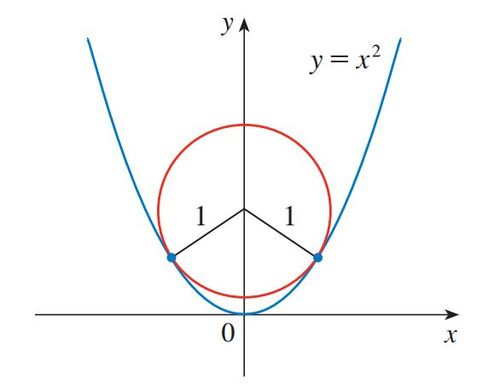Cirbola!
 The figure above shows a unit circle inscribed in the parabloa
. The coordinates of center of the circle inscribed can be written as
, where
are non-negative integers with
coprime.
The figure above shows a unit circle inscribed in the parabloa
. The coordinates of center of the circle inscribed can be written as
, where
are non-negative integers with
coprime.
Find .
The answer is 9.
This section requires Javascript.
You are seeing this because something didn't load right. We suggest you, (a) try
refreshing the page, (b) enabling javascript if it is disabled on your browser and,
finally, (c)
loading the
non-javascript version of this page
. We're sorry about the hassle.
T h e d i a g r a m i s s y m m e t r i c a b o u t y − a x i s ∴ l e t c e n t e r b e ( 0 , a ) ∴ e q . o f c i r c l e ⟶ x 2 + ( y − a ) 2 = 1 s o l v i n g w i t h t h e e q u a t i o n o f t h e p a r a b o l a y = x 2 w e g e t ⟹ x 2 + ( x 2 − a ) 2 = 1 ⟹ x 4 + ( 1 − 2 a ) x 2 + ( a 2 − 1 ) = 0 T h e p a r a b o l a a n d t h e c i r c l e w i l l b e t a n g e n t t o e a c h o t h e r w h e n t h i s e q . i n x 2 h a s r e a l a n d e q u a l r o o t s ⟹ ( 1 − 2 a ) 2 = 4 ( a 2 − 1 ) ⟹ a = 4 5 t h e c e n t e r o f t h e c i r c l e i s ( 0 , 4 5 ) s o a + b + c = 9